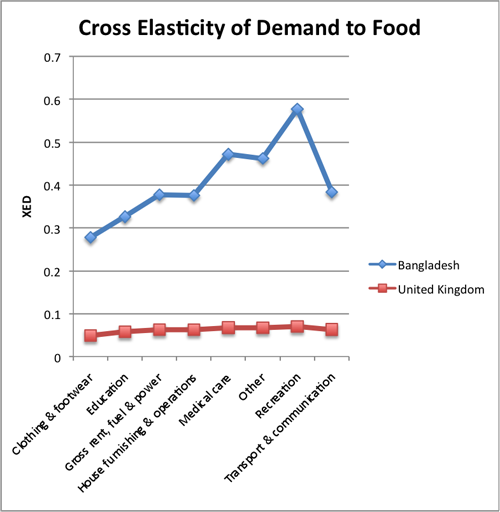A look at some different topics related to the economics of food.
Will a rise in population lead to a shortage of food?
I think most people have heard of The Dismal Prophecy of Malthus. (though Economics was termed the ‘dismal science’ for different reasons) Writing in the late eighteenth century, T.Malthus argued that the human population was doomed because the population was growing faster than the ability to grow food. He argued the simple equation of rising population and static landmass meant the world would soon be facing a shortage of food, high prices and famine. Malthus saw this as an inevitability. Yet 150 years on, his prophecy’s look ridiculously pessimistic. Despite, rapid population growth, the food supply has, until now, more than kept pace with rising demand. In fact, places like the EU were producing so much surplus food we had the much-publicised butter mountains and milk lakes e.t.c.
What Malthus failed to appreciate was that food production was not limited to the amount of fertile land.
- Relatively modest improvements in technology and farming techniques could significantly boost food production.
- Growing demand could lead to land being converted to agricultural production. For example, vast amounts of Amazon rainforest have been cut down to provide grazing for cattle
Despite frequent dire warnings, since the time of Malthus, the impending food crisis had never really materialised (with regional exceptions).
Pressures on the supply of food
Yet, just because Malthusian fears have proved wrong in the past, doesn’t mean that it will always be the case in the future. There are many trends which may disrupt future food supply.
- Increased use of Biofuels. Food such as maize are grown to provide renewable energy and an alternative to oil. However, these crops reduce the supply of food for the market. Many governments, especially in America, are committed to increasing the amount of biofuels and so this could contribute to rising prices.
- Rising world population. The global population is expected to rise from 6 billion in 2000 to 9 billion by 2050. This will place increasing strain on the land. Every year the global population rises by an estimated 60-70 million people. (another Britain to put it into perspective)
- Desertification. Global warming and other environmental shifts is decreasing the quantity of available farmland, especially on the African continent. If global warming continues water supplies could be disrupted leading to falling food production. This will only place a further strain on food prices in future.
- Diminishing marginal returns to fertilisers. The marginal gains from better technology are starting to diminish. Like anything, the use of artificial fertilisers are subject to diminishing returns. There is only so many chemicals you can use before you reach a plateau of rising production.
It is true, that the world’s capacity to produce food is still way off its maximum.
- Many countries such as India and Africa have not yet adopted many of the simplest technologies to improve food production.
- There is also the contentious issue of GM crops. GM food has potentially many problems, but, also the potential to significantly increase crop yields. A real shortage of food could well make GM food more likely to occur.
- There is the possibility of switching to more lab-grown food, that is less resource-intensive.
- There is also the possibility of the world shifting to a less intensive food diet – a shift from a meat diet to a vegetarian/vegan diet would require much fewer resources.
- Also, as food shortages lead to higher prices (as long as the government don’t distort markets by subsidising cheap food), there will be greater economic incentives for countries to increase food production.
Volatile food prices
Why can the price of food be volatile?
- Demand and supply both tend to be price inelastic
- Supply can vary due to weather, conditions e.t.c.
- What explains food price volatility?
The elasticity of Demand for Food

In the west demand for food is price inelastic. A higher price leads to only a small fall in demand. However, in developing countries, food takes a bigger % of income. If there is a rise in the price of food, there is a bigger % fall in demand for others. (less essential goods)
Market failure in food
Food may exhibit types of market failure
- Demerit good. Some foods (high sugar/fat) are likely to promote ill-health. Changing diets can have a big impact on living standards and health.
- This raises the prospect of sugar tax – a tax on sugary food to reduce demand
- Inequality. For people on low-incomes, food prices can have a big impact on living standards.
Income Decline for low-income groups
![]()
Median income after housing costs fell 12% between 2002-03 and 2010-11 for low-income decile households – while rising in all other income groups.
Food prices have risen 12% in real terms over the last five years taking us back to 1997 in terms of cost of food relative to other goods.
See also:

Quite interesting post! You are right Mathus wasn’t thinking about technology when he made his predictions.
It is in fact difficult to predict the benefits of technology, there have been cases in history where a civilization was technologically far advanced but couldn’t convert it into economic growth or prosperity. There is something in addition of technology to ensure growth. I did a bit of research about it very recently, have a post on this on my blog @ http://faux-pas.blogspot.com. Let me know what you think
perhaps to achieve the MDGs by 2015. leaders must accept that only population plays asignificant role as far as food security is concerned. we have seen technology but still majority of people go without food on the table.
So guys let assume an economy which has no government intervention which has 2 individuals producing fish and sugarcane with 2 resources labor and capital